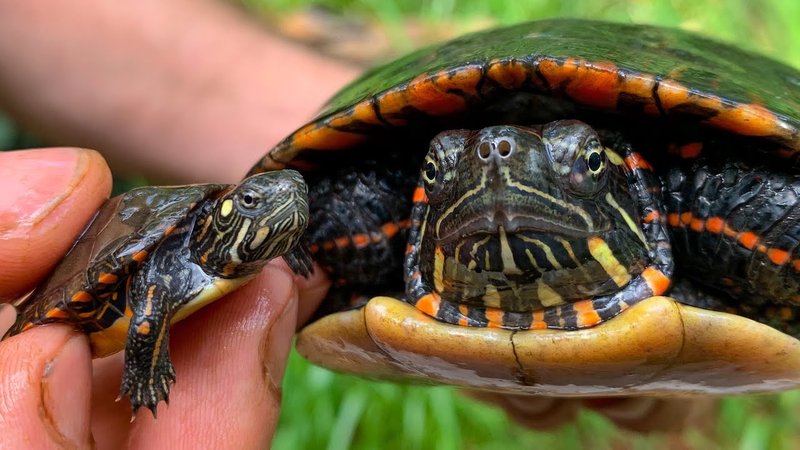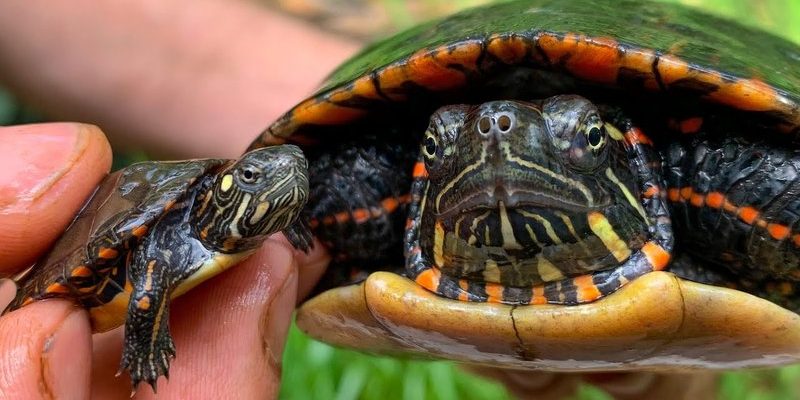
Imagine a painted turtle gliding through the water, its colorful shell shimmering under the sunlight. As it hunts, it’s not just looking for food; it’s navigating the aquatic world like a little underwater ninja. So, what exactly does this delightful creature snack on, and how does it go about finding its meals? Let’s dive into the aquatic buffet that is the painted turtle’s diet.
The Basics of a Painted Turtle’s Diet
Painted turtles are omnivores, which means they enjoy a mix of both plant and animal matter. This variety is key to their survival, offering them a balanced diet that provides the nutrients they need. When you imagine a painted turtle peeking out from under the water’s surface, think of it as a little explorer, constantly on the lookout for its next meal.
Their diet includes:
- Vegetation: Aquatic plants like algae, duckweed, and water lilies.
- Animal Matter: Small fish, insects, and even crustaceans like snails and crayfish.
- Fruits and Vegetables: They also enjoy fruits like berries and vegetables when available.
The beauty of being an omnivore is that painted turtles can adapt to whatever is available in their habitat. Whether it’s a sunny pond or a murky swamp, they’ll find the tastiest options lurking nearby.
How Painted Turtles Hunt
You might be surprised to learn that painted turtles have a unique approach to hunting. They don’t just chase their prey. Instead, they employ patience and stealth. Imagine yourself on a fishing trip: sometimes, the best way to catch fish is to sit quietly and wait for them to come to you.
Painting turtles are masters of ambush. They often stay still—blending in with their environment. When a small fish or bug swims by, they make their move. They can quickly snap their jaws to capture food, showcasing their agility despite that slow-and-steady reputation.
The Role of Vision in Hunting
A painted turtle’s eyesight is surprisingly good, especially underwater. They can spot movement from a distance and have a keen ability to focus on prey. Their eyes are positioned on the sides of their heads, allowing for a wide field of view—so they can keep an eye open for any potential meals (or predators, for that matter).
This sharp vision plays a critical role in their hunting strategy. Painted turtles often use their eyesight to detect the slightest ripples on the water’s surface, signaling the presence of potential food.
Feeding Habits and Behavior
Feeding times for painted turtles can be quite entertaining to observe. They often bask in the sun on rocks or logs before heading out to forage. It’s like they’re preparing for a meal at their favorite restaurant—getting a bit of sun to warm up before diving in.
When it’s time to eat, painted turtles usually forage alone. However, they aren’t territorial. If they find a good food source, you might see several turtles dining together, sharing in the bounty of their aquatic environment. It’s like a little buffet where everyone’s welcome!
Seasonal Changes in Diet
As seasons change, so does the availability of food. In the warmer months, painted turtles tend to eat more animal matter, as insects and small fish are plentiful. When it gets colder, they shift their diet more towards plant matter. This adaptability is key to their survival in different climates, ensuring they get the nutrients they need throughout the year.
In winter, painted turtles enter a state of brumation (similar to hibernation). They won’t be hunting at all but will rely on the nutrients stored in their bodies. It’s a remarkable survival strategy that showcases their resilience.
The Importance of A Balanced Diet
For painted turtles, a balanced diet is essential for maintaining health and energy. In the wild, they typically know what to eat, but if you’re a turtle owner, it’s crucial to provide a varied menu. A mix of greens, protein sources, and occasional treats can keep your turtle happy and healthy.
Here’s why a balanced diet matters:
- Growth: Young turtles need the right nutrients to grow strong and develop properly.
- Shell Health: A good diet supports shell health and can prevent issues like shell rot.
- Energy Levels: Proper nutrition ensures turtles have the energy to swim, bask, and explore.
Remember, just like us, turtles need a little variety in their meals to stay healthy—and happy!
Common Mistakes in Feeding Painted Turtles
Feeding painted turtles might seem straightforward, but there are some common pitfalls that many beginners stumble into. It’s important to be aware of these if you’re responsible for a pet turtle.
Here are a few mistakes to avoid:
- Overfeeding: It’s easy to think they’ll always be hungry, but overfeeding can lead to health problems. Less is often more!
- Limited Variety: Sticking to just one type of food isn’t wise. Mix it up to ensure they get all the nutrients they need.
- Ignoring Fresh Food: While commercial turtle food can be convenient, incorporating fresh veggies and occasional protein sources is key for a balanced diet.
Being mindful of these points helps ensure your painted turtle thrives, allowing it to enjoy its meals—and life!
In Conclusion
Understanding what painted turtles eat and how they hunt offers a glimpse into an incredibly adaptive species. From their patient hunting strategies to their varied diets, these turtles are more than just pretty shells—they’re a remarkable part of our ecosystem. Whether you’re observing them in the wild or caring for one as a pet, appreciating their eating habits can deepen your connection to these charming creatures.
So, next time you see a painted turtle basking in the sun or quietly hunting in the water, take a moment to marvel at the fascinating world of feeding and hunting that unfolds beneath the surface. Each painted turtle is like a little ecosystem unto itself, playing its part in the circle of life under the water.

